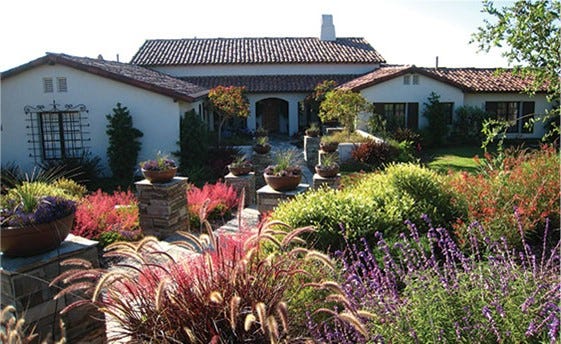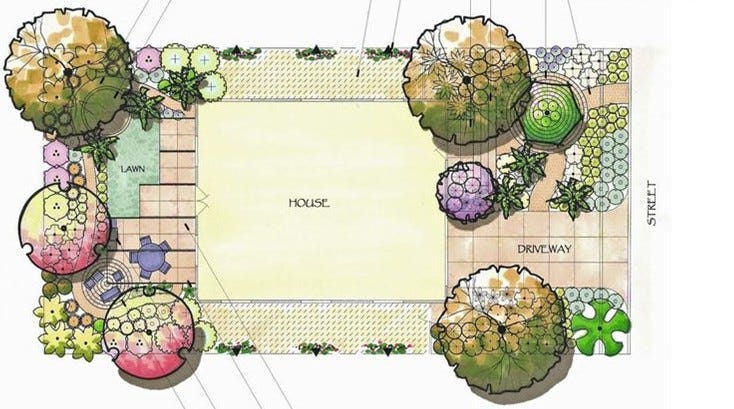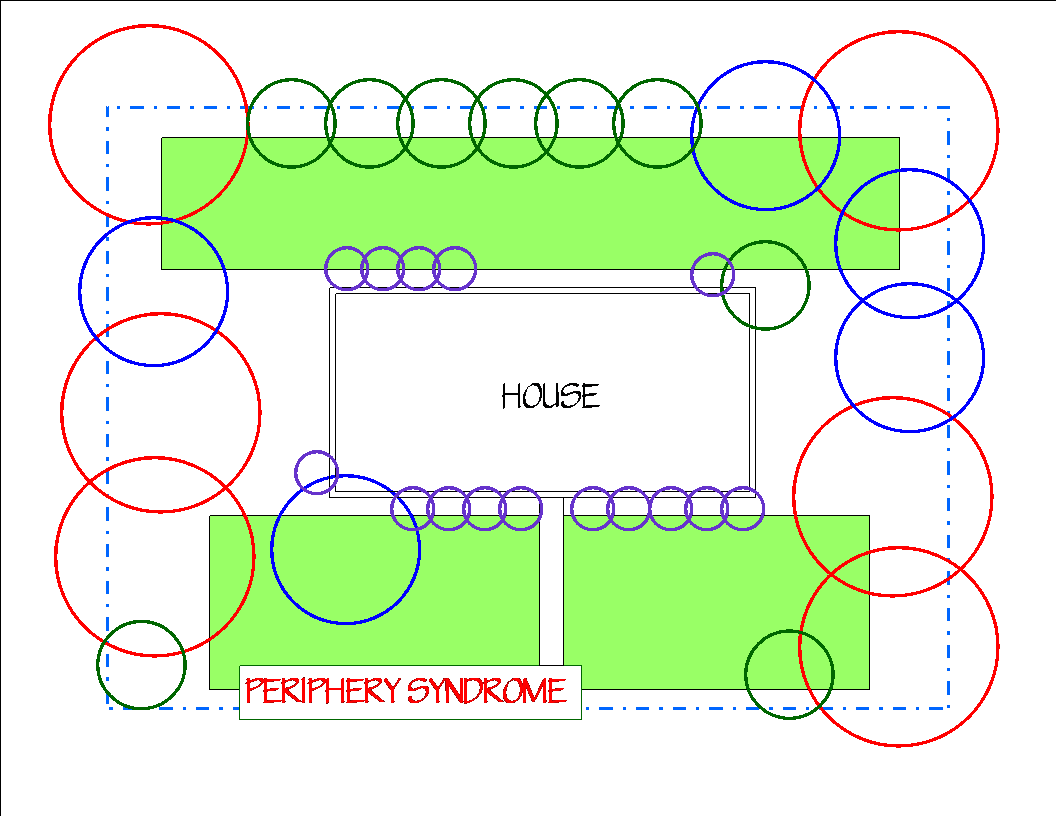THE BIGGEST MISTAKES IN LANDSCAPE DESIGN - Part 1
Covering the Key Points to Help Take a Landscape from "Drab to Fab"

Part 1 of 3
I don’t actually like the word “mistake.” First, because it’s somewhat subjective, especially in the case of “design” (kinda like art). Second, because it sounds like “clickbait” (“You’re doing *this* WRONG,” as the website states in order to get you to read through a bunch of baloney). Third, because it usually puts me on a soapbox about a common gardening attitude of “gardening is about trial and error.” Gardening is not about trial and error any more than almost any other part of life is. Millions of gardeners have come before you with the same “mistakes” and those mistakes have been recorded (in thousands of books, magazines, websites, videos, ad infinitum). There’s plenty of natural, uncontrollable elements of gardening that will provide you with a ton of mishaps and disappointments; you don’t need to intentionally set yourself up with what can be avoided. With all that said, I’m glad the word “mistake” grabbed your attention long enough to read to this point, at the least. No baloney here.
One thing I tried to get across when I taught landscape design are the differences between gardening, collecting plants, arranging plants in various places within a garden, and full-blown landscape design. Gardening is buying and planting a particular plant for a particular reason and tending to it as best you can. Collecting plants is buying and planting plants that fit into a particular fashion/trend or passion or botanical objective (“succulents” for example). Arranging plants is putting plants into a specified area and placing them in a pleasing manner, such as short in front, tall in back or gathering together spring bloomers with summer bloomers with, the rarely considered, fall bloomers.
Landscape design is probably all of the first three. And then some. It’s about a landscape’s function, a family’s wants and needs, considering maintenance before you have actual maintenance, creating a pleasing layout, and, maybe most of all, developing a “message” or “style.”
LET ME START WITH THE UNNUMBERED, THE OBVIOUS:

NO PLAN
Many home landscapes evolve helter-skelter. We gardeners attack our yards in piecemeal fashion.
A plant is planted somewhere in the yard simply because there is room for it there at the time. We want to grow flowers so we cut a little circle in the middle of the lawn and fill it with zinnias. Then we notice the backyard has a sunny spot, so we square it off with timbers and plant tomatoes and some vegetables. Next we see a few trees for sale at the nursery, take them home, and plunk them down along the driveway.
Before long our efforts amount to a "creeping landscape," a hodgepodge, random assault, where pathways are often inefficient and at no time does the landscape ever emerge as a unified whole.
The key to good landscape design is to design the big picture first. The digging shouldn't start until the whole property is designed on paper.
The little areas – the best spot for an herb garden, perennial beds, a child's play area – come from the big areas, not the other way around.
You don't need to install the entire landscape all at once. You can whittle away at the plan over two, five, even ten years.
No matter -- every time you complete a portion, it fits and looks good with the work done before, and the work to follow.
Creating a plan FORCES you to look at the big picture, as well as details, rather than just piecemealing your project as you go and reacting after the fact to errors made. You create a “Master Plan.”
Just to cover my as*…em, bases, I know many people who don’t/didn’t put a plan to paper or even put lines out on the site yet end up with a sumptuous landscape. There are plenty of people who can and do see the big picture as well as all the little pictures from the beginning. And they keep it all in mind as they “develop” the landscape from start to an acceptable finish over a matter of months or even years. Best of all, they can quickly shift gears when their ideal element or plant isn’t available and then choose a sometimes-better one instead.
Of course, there’s also the very important bottom line: if YOU like your garden “design,” however you’ve created it and no matter what might be inconsistent with principles of design, then that’s all that matters. So, for the rest of you, those who are unsure of their designing skills and those interested in avoiding some pitfalls in the hopes that they might create something “special,” I offer these suggestions, the nitty-gritty…
THE TOP SIXTEEN MISTAKES
— a la Letterman style —
16. NOT CONSIDERING EVERYONE’S NEEDS AND WANTS
Spend time planning early on with EVERYONE in the family so your landscape fulfills all of your family's needs.
Start with a wish list, no matter how outrageous, and pare it to your time and energy budget. MAYBE to a financial budget.
KEEP IN MIND: Each "use" (playing, barbecuing, bird-watching, reading) does not necessarily require a separate area, but can overlap others or be sprinkled around the yard.
15. THINKING TOO BIG, AMBITIOUSLY -- PROJECT-WISE
Don't get overwhelmed -- thinking that you have to design and install the entire property as one big entity.
Break it up. Start with a “Master Plan” showing at least the ACTIVITY AREAS. Then you can take a small section at a time and plan the details of each section as you go.
The “Master Plan” concept – as already noted – also avoids higgledy-piggledy, Rube Goldberg designs.
14. NOT RELATING THE LANDSCAPING TO THE HOUSE
Many beginners plan a yard as if it's in a world of its own, leaving the house looking like an ill-dressed tourist.
Your landscape should complement your home -- not hide it.
The landscape should frame, embellish, and enhance the house.
The house and yard should work together in terms of style, scale, colors, and materials.
You should repeat architectural lines of the house in the landscape – either with plants or construction such as walls, fences, etc.
You should “connect” to the house. Lines of the landscape should meet up with some feature of the house.
MOST IMPORTANTLY, the style of the landscape should match the style of the house’s architecture.
13. NO SENSE OF BOUNDARY
Plants are placed along the fence or along the house -- with nothing in-between.
Rather than string a line of shrubs along the house, bring the plantings out into the yard with various levels of plants, deeper borders, and curves.
Don’t get stuck in the “periphery syndrome” -- planting a narrow strip of ground around each building, wall, paved surface and all along the boundary lines.
Why squander what may be the most valuable real estate in the whole yard -- the wide open space in the middle -- to be claimed only by a grass lawn? That’s a waste.
Next week: Part 2 - #12. BACKYARD MYOPIA to #8b. NOT FIXING PROBLEM SITES
© Copyright Joe Seals, 2025




